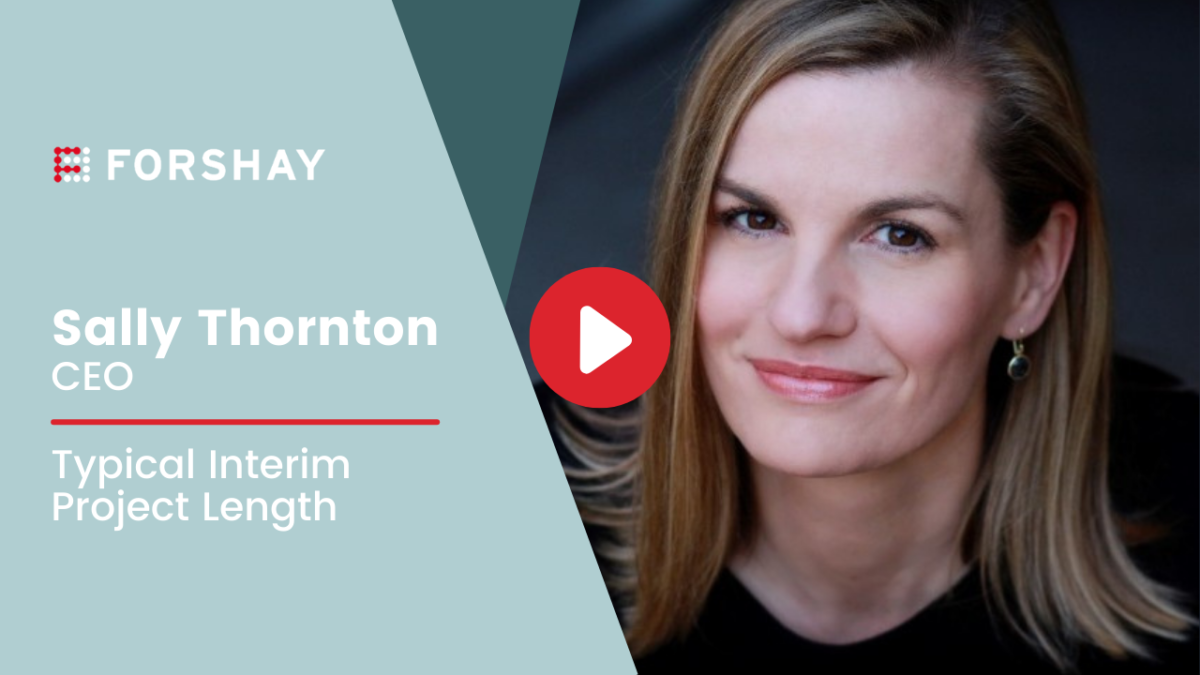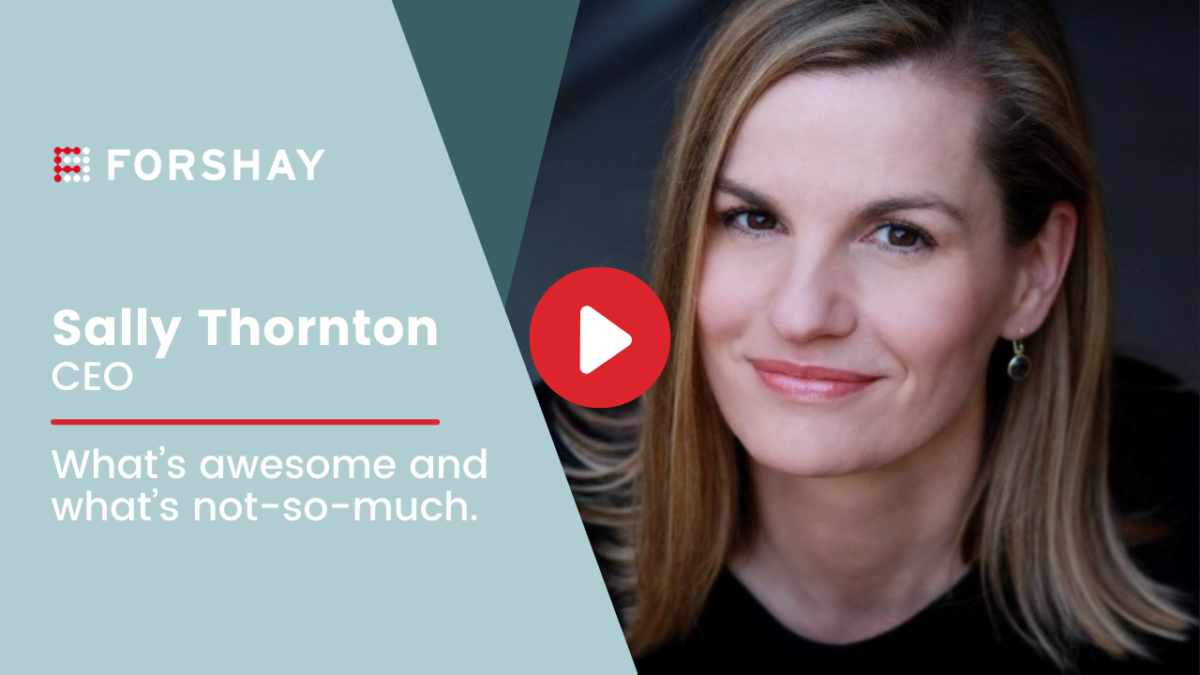What are the three advantages to hiring interim professionals and what might be a drawback (and how do you mitigate that)? Get the insider info from Forshay founder and CEO Sally Thornton in this 77 second video.
Pros and Cons of Interim Hiring


What are the three advantages to hiring interim professionals and what might be a drawback (and how do you mitigate that)? Get the insider info from Forshay founder and CEO Sally Thornton in this 77 second video.

Discover the typical length of time our clients hire interim marketing and HR roles in this quick hit video from Sally Thornton.

What is your number one rule in hiring? Sally Thornton, CEO and Founder of Forshay shares what’s worked best for her team + clients.

Let’s be real. Fitting in can be overrated. After all, the people who make history aren’t conventional. Being an outsider may feel like a bad thing. It could make you feel unsafe or disconnected or misunderstood. But research proves that there’s a bright side, even creative power, in thinking differently. So, how do you do both? Is it possible to be both in and out? Yes.
We’re not saying it’s easy. For anyone who has not yet seen (but will soon be obsessed) over the show Ted Lasso, outsiders typically have a very rough road. But Ted embraces his “outsider-ness” in a surprisingly easy way that is rich with comedy, and science backs him up… creativity can flourish when you are not part of the “in” group.
Now from comedy to reality…remember when you were a kid? Being considered ‘weird’ was not a good thing. We all have a built-in defense mechanism for being anything other than normal. What’s the problem with being normal though?
So, what’s the strategy? Olga Khazan, a staff writer at The Atlantic, has a few insights as she literally wrote a book on it: Weird: The Power of Being an Outsider. Sure, sharing your “coloring-outside-the-lines ideas” can feel terrifying. But fret not. Khazan has a pretty straightforward strategy. First, become part of your company’s culture. Go to parties (virtually in COVID). Engage in meetings. Show that you care about the other members of your group, as that gives you the virtual “in”. Once you show that you can be trusted, they’ll be more interested in (and tolerant of) your so-creative-it-might-have-felt-scary-before ‘outsider’ ideas.
Now all kinds of magic can happen. Creative thinking is what has powered the best ideas (business and otherwise) since forever.
What if creativity is tricky because the team just feels overworked? There’s more than one way to get outside thinking. One way is to tag someone in. Have a sticky problem that no one seems to have the bandwidth or ingenuity to solve? Bringing in someone who is literally outside of your organization is one way to get a fresh perspective. That’s where we can come in. We’ve seen our clients bring in an interim person to think differently–like a compensation person who rethinks and redesigns a key incentive plan or an organizational designer who redesigns a company’s performance management from an outdated approach to a more modern one.
Another way is to seek your Insider Outsiders within your organization. Identify those people who often come up with creative, unique insights to a problem and who offer a perspective no one has thought of. As leaders, the simple act of encouraging your lovable “weirdos” to test out new ideas in a safe environment is all it takes.
https://hbr.org/2017/05/what-the-best-transformational-leaders-do

You may have heard of two different kinds of mindsets. Growth and Fixed. Fixed mindsets believe there’s a right way and a wrong way, that you’re a “creative person” or a “math person”, and that all these things are fixed. But growth mindsets are infinitely more flexible and bendy. Think of it like this. Fixed mindsets like to travel on a straight line. Growth mindsets expect there will be roots in the way, blind curves, and lots of ups and downs. There’s a third factor: empathy. And it’s a secret ingredient that makes a growth mindset more powerful.
But of course, applying mindsets to life and work isn’t that simple. Sometimes you really are on a straight path, and it’s fine to have a fixed mindset. It could help you stay focused on your goal. And Carol Dweck herself is clear that it’s false to think we have a growth mindset all the time. Most of the time, however, we want to actively cultivate our own (and our team’s) growth mindset. There are fewer straight paths, and life may throw you new challenges like crossing a raging river or figuring out how to handle that bear that just crossed your trail (Hint: Make noise. Bears hate to be surprised.).
First, here are some real-world work problems. Leaders who primarily have a fixed mindset can create a “talent race” within their team, calling out who is “high potential”, or who is “smart” as fixed traits. Whereas, leaders who primarily have a growth mindset can create a learning orientation to problem solving, and an inclusive, collaborative team environment where people build on one another’s ideas, or challenge one another knowing it’s not challenging their identity (as “smart” or “not smart”).
So here’s the next-level twist… Researchers have found that people with a malleable mindset about empathy (think “growth mindset + inclusivity”) are able to be more empathetic in difficult contexts than those who believe that empathy cannot be developed. And we are living in some difficult contexts this year!
According to the Harvard Business Review, “Making Empathy Central to Your Company Culture”,
Empathic workplaces tend to enjoy stronger collaboration, less stress, and greater morale, and their employees bounce back more quickly from difficult moments….
The same article has some great news. Empathy is not a trait. It’s a skill. Meaning, it can be built, finessed, and worked on. Like learning how to ride a bike, play a guitar, or balance a budget, empathy can be practiced and improved.
One strategy for putting empathy into practice with your team is to focus on their effort and strategy, and less on their outcome. Effort (read: working hard on something) is much easier to control and grasp than something vague like “you just need to do better.” And by focusing less on the outcome, it allows for your team to experiment more creatively, learning from the process and refining their strategies.
Want some other ideas on how to light up your growth mindset and filter it through your company culture? Check out our “3 Habits of Inclusive Leaders” article. Still have questions? Let’s chat!
